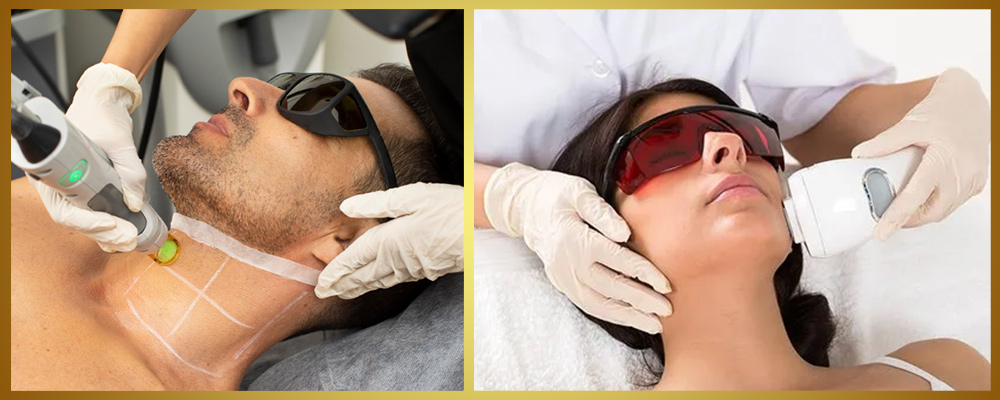Table of Contents
Laser Hair Reduction: Types, Symptoms, and Causes
Laser hair removal is a popular long-term solution for reducing unwanted hair by using concentrated light to target hair follicles. It slows hair growth, though multiple sessions are often necessary for permanent results.
Types of Laser Hair Reduction

1. Alexandrite Laser
Effective for light to olive skin tones, the Alexandrite laser is fast and suitable for treating large areas like the legs and back.
2. Diode Laser
The Diode laser works well on both light and dark skin tones and is ideal for coarse hair in areas like the underarms or bikini line.
3. Nd: YAG Laser
Perfect for darker skin tones, the Nd laser penetrates deeper into the skin, making it safer for those with more melanin.
4. Ruby Laser
One of the oldest types, the Ruby laser is suitable for light skin and fine hair, though it’s not as commonly used today.
Symptoms
a. Redness and swelling Common symptoms are redness and swelling. This usually disappears within a few hours.
b. Skin irritation There may be slight itching or irritation. But it usually disappears within a day.
c. Pigmentation changes Especially for darker skin tones. The treated skin may temporarily darken or lighten. But they usually get resolved over time.
d. Blisters or scabs It’s rare but can happen if care instructions aren’t followed properly afterward.
When to See a Doctor
1. Sudden or Patchy Hair Loss: Seek immediate attention for rapid or noticeable shedding.
2. Significant Thinning: If hair thinning impacts your self-esteem, consult a professional.
3. Scalp Issues: Itching, redness, or flaking could indicate an underlying skin condition.
4. Family History: Early evaluation is wise if hair loss is common in your family.
5. Ineffective Treatments: If over-the-counter solutions don’t work after a few months, consider seeing a doctor.
Causes
a. Hormonal Imbalance Conditions such as PCOS or Cushing’s syndrome can cause hair to grow too long due to high androgen levels.
b. Genetics Family history often plays a role in hair density and growth patterns.
c. Medications Some medications, such as steroids, can increase hair growth as a side effect.
d. Lifestyle Stress, eating, And overall health also affects hair growth. Excessive hair can be a result of hormonal stress.
Benefits of Laser Hair Reduction
a. Precision: Targets dark hair with minimal damage to surrounding skin.
b. Speed: Quick treatment time, especially for small areas like the upper lip.
c. Predictability: After several sessions, many people experience permanent hair reduction.
Diagnosis
Laser hair removal begins with a consultation where a dermatologist evaluates your skin type, hair color, and thickness. This assessment helps determine the best laser for you. No complex tests are needed, but a patch test may be conducted to check skin sensitivity.
Treatment Steps
1. Pre-Treatment Care
a. Shave the area 24-48 hours before the session.
b. Avoid sun exposure and tanning for two weeks prior.
c. Refrain from waxing or plucking for four weeks before treatment.
2. Procedure
a. A cooling gel or numbing cream is applied.
b. The laser targets hair follicles with light pulses to reduce hair growth.
c. Treatment duration varies: small areas take a few minutes; larger areas may take up to an hour.
3. Post-Treatment Care
a. Mild redness or swelling is common and usually subsides quickly.
b. Use soothing aloe vera or ice packs if needed.
c. Protect treated areas from sunlight and apply sunscreen.
4. Session Frequency
a. Multiple sessions (typically 6-8) are needed, spaced 4-6 weeks apart for best results.



